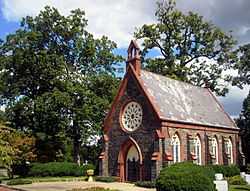Oak Hill Cemetery Chapel (Washington, D.C.)
|
Oak Hill Cemetery Chapel | |
|
U.S. National Historic Landmark District Contributing Property | |
 | |
|
Oak Hill Cemetery Chapel in 2008 | |
 | |
| Location |
29th and R Streets NW Washington, D.C. United States |
|---|---|
| Coordinates | 38°54′46″N 77°3′32″W / 38.91278°N 77.05889°WCoordinates: 38°54′46″N 77°3′32″W / 38.91278°N 77.05889°W |
| Built | 1850 |
| Architect | James Renwick, Jr. |
| Architectural style | Gothic Revival |
| Governing body | Oak Hill Cemetery Company |
| Part of | Georgetown Historic District (#67000025) |
| NRHP Reference # | 72001429[1] |
| Significant dates | |
| Added to NRHP | March 16, 1972 |
| Designated NHLDCP | May 28, 1967[2] |
The Oak Hill Cemetery Chapel, also known as the Renwick Chapel or James Renwick Chapel,[3] is a historic building in the Georgetown neighborhood of Washington, D.C., United States. Designed by James Renwick, Jr. in 1850,[4] Oak Hill Cemetery Chapel is the architect's only known example of Gothic Revival church architecture in Washington, D.C.[5] It is located on the highest ridge in Oak Hill Cemetery, near the intersection of 29th and R Streets NW.[6] The chapel is one of two structures in Oak Hill Cemetery listed on the National Register of Historic Places; the other being the Van Ness Mausoleum. The chapel, mausoleum, and cemetery are contributing properties to the Georgetown Historic District, a National Historic Landmark.[2][1]
History
On June 7, 1848, businessman and philanthropist William Wilson Corcoran (1798–1888) purchased Parrott's Woods, a 15-acre (6.1 ha) forest overlooking Rock Creek Park, from Lewis Washington, great-grandnephew of President George Washington. Corcoran organized a company to establish a cemetery, and on March 3, 1849, the Oak Hill Cemetery Company was chartered by an Act of Congress.[4][7]
Architect James Renwick, Jr. (1818–1895) was chosen to design a small chapel for the new cemetery. Renwick, whose best known works include Grace Church, St. Patrick's Cathedral and the Corcoran Gallery of Art (currently the Renwick Gallery),[8] began designing the chapel soon after he had finished the plans for the Smithsonian Institution Building.[9] The cost of constructing Oak Hill Cemetery Chapel was $9,400, which was paid by Corcoran.[7]
On March 16, 1972, the National Park Service added Oak Hill Cemetery Chapel to the National Register of Historic Places.[2]
Architecture
Oak Hill Cemetery Chapel is considered an excellent example of Gothic Revival architecture, and often called a "miniature Gothic gem".[5][6] It features a steeply designed pitched roof, buttresses, and stained glass lancet windows accented with tracery. The chapel is a one-story, rectangular building measuring 23 feet (7.0 m) high and 41 feet (12 m) long.[5][10]
The building materials consist of Potomac gneiss, sandstone, and wood. A cornerstone, inscribed with the date "1850", is located in a buttress on the chapel's northwest corner. The chapel is accessible by a large, painted door on the west side. The door is protected by a padlocked, wrought iron gate; the padlock bears the inscription: "Presented/Oak Hill Cemetery Co./By/James L. Norris/March 19, 1895." A rose window with wooden mullions is located above the door.[4][6]
Influence
The design of Grace Episcopal Church, a Gothic Revival church built in 1867, is very similar to that of the nearby Oak Hill Cemetery Chapel. Although the architect of Grace Episcopal Church is unknown, there is reason to believe Renwick may have designed the building. If this isn't the case, the person who designed the church was greatly influenced by Renwick's work.[11]
See also
References
- ↑ 1.0 1.1 "National Register Information System". National Register of Historic Places. National Park Service. 2008-04-15.
- ↑ 2.0 2.1 2.2 "District of Columbia - Inventory of Historic Sites" (PDF). District of Columbia: Office of Planning. Government of the District of Columbia. September 1, 2004. Retrieved July 19, 2009.
- ↑ Tischler, Gary (November 3, 2005). "Georgetown tour offers gentry's look at history; Period architecture, names, lifestyles come alive.". The Washington Times (Goliath). Retrieved July 19, 2009.
- ↑ 4.0 4.1 4.2 Moeller Jr., G. Martin (October 24, 2006). Christopher Weeks, ed. AIA Guide to the Architecture of Washington, D.C. (Fourth ed.). Baltimore: The Johns Hopkins University Press. p. 239. ISBN 0-8018-8468-3. OCLC 63660484. Retrieved July 19, 2009.
- ↑ 5.0 5.1 5.2 "Oak Hill Cemetery, Chapel, & Gatehouse". National Park Service. Retrieved July 19, 2009.
- ↑ 6.0 6.1 6.2 Raiff, Daniel D.; United States Commission of Fine Arts (September 1969). "Oak Hill Cemetery Chapel: HABS No. DC-172". Historic American Buildings Survey. Library of Congress. Retrieved July 19, 2009.
- ↑ 7.0 7.1 Jackson, Richard Plummer (1878). The Chronicles of Georgetown, D.C., from 1751-1878. Washington, D.C.: R. O. Polkinhorn. pp. 264–268. OCLC 2276711. Retrieved July 19, 2009.
- ↑ "Architectural History of the Renwick Gallery". Renwick Gallery. Smithsonian American Art Museum. Retrieved July 19, 2009.
- ↑ Evelyn, Douglas E. (2008). On This Spot: Pinpointing the Past in Washington, D.C. (Third ed.). Sterling, Virginia: Capital Books. p. 229. ISBN 1-933102-70-5. OCLC 223851856. Retrieved July 19, 2009.
- ↑ Fisher, Dr. Richard Swainson (1852). Gazetteer of the State of Maryland. New York City: J. H. Colton. p. 119. OCLC 3456096. Retrieved July 19, 2009.
- ↑ Noffsinger, Dr. James Philip; Thomas R. Martinson (September 7, 1966). "Grace Protestant Episcopal Church: HABS No. DC-101". National Park Service. Library of Congress. Retrieved July 19, 2009.
External links
| Wikimedia Commons has media related to Oak Hill Cemetery Chapel. |
| ||||||||||||||||||||||||||